Korean LED chip manufacturer Seoul Semiconductor unveiled its breakthrough second generation CSP LED product Wicop2, and spoke about its future outlook during a press conference at the Marriot Hotel in Shanghai, China on Tuesday.
“Seoul Semiconductor aims to become the world’s largest LED manufacturer by 2019,” said the company CEO Chunghun Lee at the press conference.
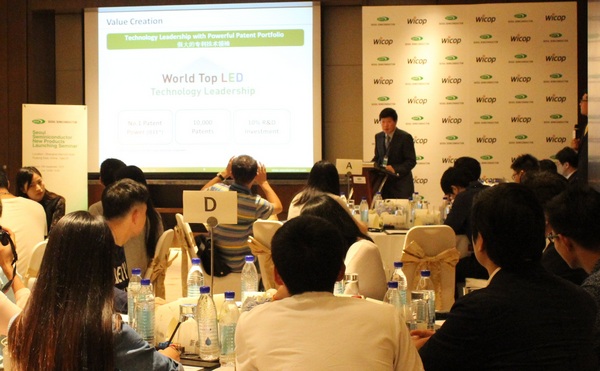 |
|
Seoul Semiconductor CEO Chunghun Lee at Wicop2 LED product launch at the Marriot Hotel in Shanghai, China. (Photo courtesy of Seoul Semiconductor) |
“Our company invests about 10% of our revenue on R&D every year, and currently holds more than 10,000 global patents,” said Lee. “We have been selected by the Institute of Electrical and Electronics Engineers (IEEE) as the world’s top patent power company.”
For the Korean manufacturer business is more than selling products to clients, it is about offering the company’s product values, added the company CEO.
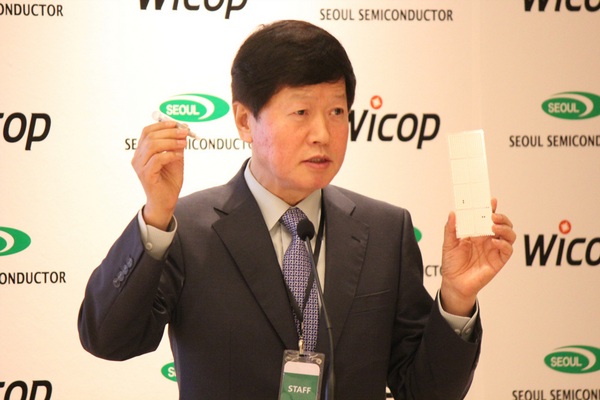 |
|
Seoul Semiconductor CEO Chunghun Lee holds up LED package components during Wicop2 product presentation. (Photo courtesy of Seoul Semiconductor) |
The company highly values innovation, and creating added value through its R&D process. Seoul Semiconductor was one of the first companies to launch the popular Acrich LED product series in the LED industry, and GaN-on-GaN-based nPola LEDs. The launch of these products gave the industry a new LED technology development direction.
However, these are not the only products that Lee aims to utilize to claim its top market position. Seoul Semiconductor is the first company in the LED industry to launch a Wafer Level Integrated Chip on PCB (Wicop) LED.
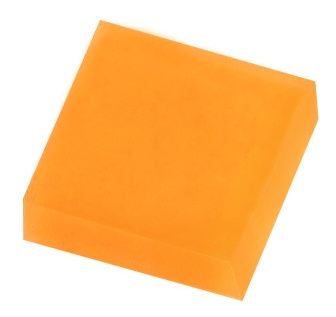 |
|
Seoul Semiconductor's package-free Wicop2 LED. (Photo courtesy of Seoul Semiconductor) |
Wicop2 is a simpler CSP LED design. The design challenges the necessities of using traditional LED package materials including leadframes, die bonding, and gold wiring. What would happened if these package materials were removed? These concepts shaped the company’s new wafer level Wicop LED. Nobel laureate in physics, Shuji Nakamura, who is also the company’s technology consultant recommended using reverse thinking during their product design and invention process. It is apparent that Wicop is the result of reverse thinking, and the displayed product at Marriot Hotel in Shanghai did not require die bonding, leadframes, or wire bonding. All the new generation LED product manufacturing process required was thin phosphor film coated on the LED chip.
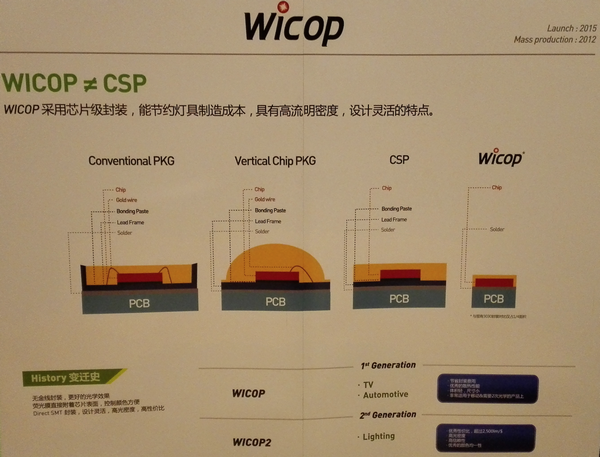 |
|
Comparison of Seoul Semiconductor's Wicop2 with other traditional LED package types. (LEDinside) |
Seoul Semiconductor’s new product strategy comprises four strategic products Wicop, Acrich, nPola and UV LED product Violeds. How did Wicop earn such an important market strategy position?
Since Wicop is a package-free LED, it is very small (1.5 mm x 1.5 mm), and has a wide beam angle of 120 to 150 degrees. Hence, the product is suitable for applications that require secondary optic designs.
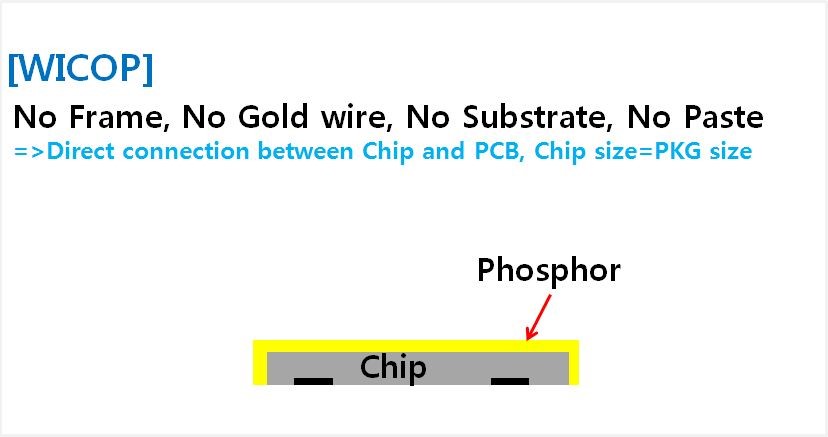 |
|
A diagram of Seoul Semiconductor Wicop2 LED structure. (Photo courtesy of Seoul Semiconductor) |
The LED chip is directly connected onto the PCB, hence its thermal dissipation channel is especially short, and has low thermal resistance. The driving current is double that of the average LED package, and is reach the ultrahigh 2,500 lm/ US$ cost performance ratio.
This technology directly connects the phosphor film with the LED chip, and is able to achieve even more uniform LED color illumination. The LED is capable of overcoming traditional phosphors flaws of imprecise control of LED color distribution on the McAdam ellipse.
Since the Wicop2 LED significantly reduces the manufacturing process, it can also greatly cut LED package material costs, and mass production of the chip presents competitive cost advantages. Seoul Semiconductor started the Wicop R&D process in 2012, and started to widely apply the product in direct-lit LED TV markets in 2013. The product gradually replaced 2835 LEDs to become a major component in TV backlight products.
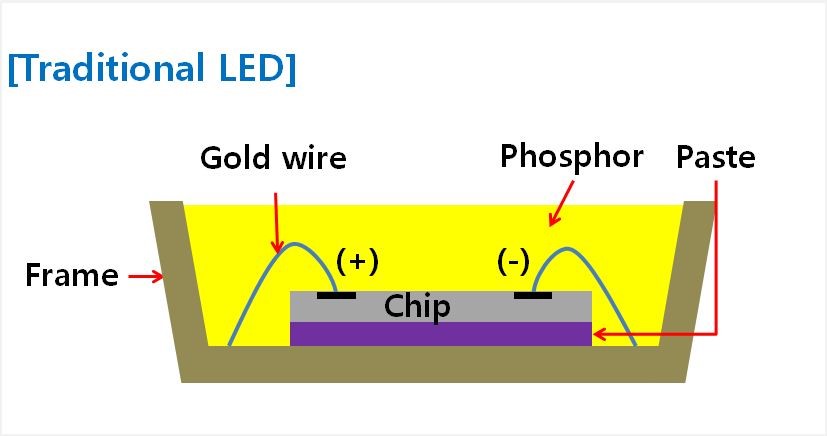 |
|
In comparison the traditional LED structure uses a lot more LED package materials. (Photo courtesy of Seoul Semiconductor) |
After developing the product for three years, and spending another two years verifying the product in real-time applications, Seoul Semiconductor released the technologically mature and optimized Wicop2. It is believed the product will follow in the footsteps of 5630 and 2835 LEDs, and build upon the huge production capacity it accumulated in the backlight market before entering the lighting market, which holds great market potential and where the product will have considerable Cost/Performance ratio advantages.
“We believe Seoul Semiconductor’s Wicop2 will be used in many lighting products around us very soon,” said the company’s General Manager for the Greater China area Eric Lee. “Seoul Semiconductor was devoted to LED technology for the last 23 years, and we are very proud that our latest Wicop2 will be leading LED technology advancements in the industry.”
Wicop has evident advantages, and a relatively simple production process. Wicop does not require die bonding, wire bonding or even dispenser machines during the entire manufacturing process, said Lee. The chip does not even require leadframes, gold wires and all sorts of adhesives. This new technology can completely turnaround the LED industry. Seoul Semiconductor projected these changes would take place fairly early on, and stopped manufacturing materials that might be eventually eliminated from the market.
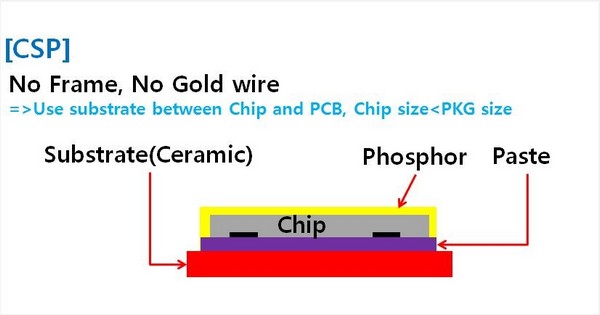 |
|
The CSP LED has a simpler structure than traditional LEDs, but Seoul Semiconductor's Wicop 2 is even simpler than that. (Photo courtesy of Seoul Semiconductor) |
For LED package manufacturers, Wicop2 is nothing but bad news. Following the proliferation of Wicop technology, the value of LED package manufacturers might be completely replaced in the supply chain. The spread of Wicop could even impact Seoul Semiconductor, which owns a huge LED package business itself. Asked about his perspective on the matter, Lee used mobile phone manufacturers case studies as an example. Nokia once claimed more than 40% market share in the mobile phone market. At the time Sony Eriksson and Motorola both imitated Nokia’s business strategy and viewed it as their contender. Everything changed when Apple founder Steve Jobs integrated computer functions into the mobile phone, and introduced the game changing smartphone onto the market, which resulted in the withdraw of mobile phone giants Nokia and Motorola from the mobile phone market.
Manufacturers can only become market leaders in the ever-changing market through innovation and creativity, and only then will they become fearless of market transformations, said Lee. This is why Seoul Semiconductor has continued to invest 10% of its revenue in R&D, he added.
(Author: LEDinside staff, Translation: Judy Lin, Chief Editor, LEDinside)





 CN
TW
EN
CN
TW
EN












